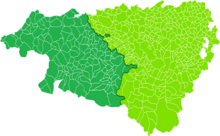
Back Frans-Baskeland Afrikaans Baskenland (Frankreich) ALS Iparralde AN إقليم الباسك الفرنسي Arabic Fransa Bask ölkəsi Azerbaijani Iparralde Breton Sjeverna Baskija BS Iparralde Catalan Francouzské Baskicko Czech Iparralde Welsh





The French Basque Country (French: Pays basque français; Spanish: País Vasco francés), or Northern Basque Country (Basque: Ipar Euskal Herria, or Iparralde, lit. 'the Northern Region'), is a region lying on the west of the French department of the Pyrénées-Atlantiques. Since 1 January 2017, it constitutes the Basque Municipal Community (Basque: Euskal Hirigune Elkargoa; French: Communauté d'Agglomeration du Pays Basque) presided over by Jean-René Etchegaray.[1][2]
It includes three former historic French provinces in the north-east of the traditional Basque Country totalling 2,967 km2 (1,146 sq mi): Lower Navarre (French: Basse-Navarre; Basque: Nafarroa Beherea), until 1789 nominally Kingdom of Navarre, with 1,284 km2 (496 sq mi); Labourd (Lapurdi), with 800 km2 (310 sq mi); Soule (Zuberoa), with 785 km2 (303 sq mi). The population included in the Basque Municipal Community amounts to 309,723 inhabitants distributed in 158 municipalities.[3]
It is delimited in the north by the department of Landes, in the west by the Bay of Biscay, in the south by the Southern Basque Country and in the east by Béarn (although in the Béarnese village of Esquiule, Basque is spoken), which is the eastern part of the department. Bayonne and Biarritz (BAB) are its chief towns, included in the Basque Eurocity Bayonne-San Sebastián Euroregion.[4] It is a popular tourist destination and is somewhat distinct from neighbouring parts of the southern Basque Country, since it was not industrialized as Biscay or Gipuzkoa and remained agricultural and a beach destination.
- ^ "Abian da Euskal Elkargoa [The Basque Community kicks off]". EITB. 2017-01-02. Retrieved 2017-02-02.
- ^ Sabathlé, Pierre (2017-01-23). "Jean-René Etchegaray élu président de la communauté d'agglomération Pays basque". SudOuest. Retrieved 2017-02-02.
- ^ "Aujourd'hui, 10 intercommunalités en Pays Basque". Communauté Pays Basque. Communauté Pays Basque. 2015. Archived from the original on 2017-06-29. Retrieved 2017-02-03.
- ^ "Basque Eurocity". MOT, Mission Opérationelle Transfrontalière. French Govt. Archived from the original on 2017-12-10. Retrieved 2017-02-02.